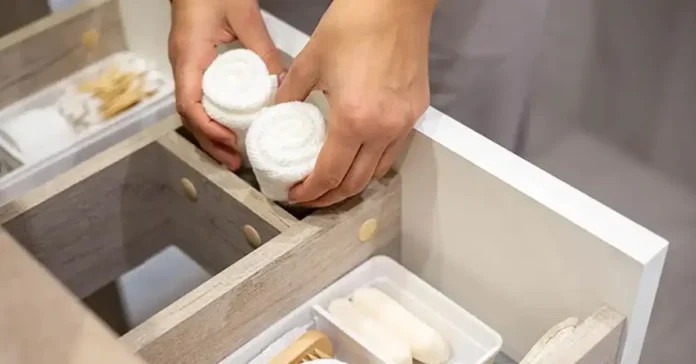In this comprehensive guide, we’ll delve into the art of decluttering, a crucial step in any renovation or downsizing project. Whether you’re preparing for a relocation, optimizing car storage, or considering self-storage solutions, decluttering is the first and most essential task. Each room presents unique challenges and opportunities for decluttering. From creating functional storage solutions to deciding what to keep, donate, or discard, this guide will provide actionable steps and practical tips.
We’ll explore how decluttering not only enhances the aesthetics of your home but also improves functionality and creates a more organized living space. Whether you’re a minimalist or someone looking to reclaim lost space, this guide is tailored to help you achieve your decluttering goals effectively.
Get ready to transform your living spaces, simplify your life, and embark on a journey toward a clutter-free home that reflects your lifestyle and personality.
How to Declutter House?
Clutter does not mean that every inch of the flooring is covered in shoes, clothes, wet towels, and old newspapers. When you have more things than you need there is clutter. Having a shelf or a cupboard laden with items you have not touched in more than six months and will mostly remain untouched for another six months or having storage cabinets filled to bursting point with articles that you believe you may need but will never use are all examples of clutter. Living amid all these things will only make your life harder.
Five Reasons to Declutter Your Home
1. It Is Easier to Clean and Maintain a Decluttered Home.
When your shelves are littered with trinkets and rooms lined with too much furniture and artefacts, dusting and cleaning becomes a tedious task. If you do not clean up regularly, layers of dusk will shroud everything. The best thing to do is keep what you need and put the rest in storage.
2. It is easier to organise your things
Once you declutter your home you will have fewer things to deal with. Assign a specific place for everything. Ensure you put things back in their right place to keep things neat and organised. Since all the unnecessary stuff has been sold and the less used items are in storage, you have fewer things to organise. Life is so much simpler one you declutter.
3. It creates a more open and spacious ambience
Instead of feeling choked by unnecessary objects lying around the house, once you declutter you will enjoy the empty spaces. The minimalist route is trending today. It gives the house a more classy, urban appearance. Once you declutter and choose minimalism, you will not waste money on buying items that you do not need.
4. It gives you a chance to redecorate
Just like you enjoy wearing different attire every day, decluttering will help give your home a distinctive look. You can put away some furniture and artefacts in a self-storage unit. You can take them back home whenever you want, and store away previously used pieces. This way you will be redesigning your living space without having to go through with a full-fledged renovation.
5. It saves you from embarrassment and stress
Most of the time you become aware of the clutter only when you are expecting guests over. It is too embarrassing to have unwanted things lying around and it is too stressful trying to cram everything overnight into the limited storage cabinets around the house. A study revealed that 42.5% of people are embarrassed by the clutter at home and 61.7% revealed that cluttering reduced their overall stress levels. Decluttering will save you from the embarrassment and relieve you from living in a messy home.
5 Tips on How to Declutter your Home
Decluttering your home might seem like a herculean task. However, once you get started you will realise that you are doing yourself a favour and you will find yourself purging your home with flair. For those of you who find it particularly difficult to get rid of things for sentimental reasons even if the item in question is worn out and useless, here are a few tips to help you get started.
1. Set aside a small amount of time
Sometimes the idea of spending hours doing a chore can seem daunting or even plain boring. If the time factor is the problem, then start with as less as five minutes. Keep going only if you feel motivated too. Else stop after five minutes and resume later or even the next day.
2. Start with objects of little value
If you are the sentimental type of person, you might find it difficult to get rid of many things around your house. You need to begin decluttering by picking out items that are inexpensive and have no sentimental value.
3. Remember self-storage units are an option
You may not have use for certain articles but for personal reasons you may not want to get rid of them either. Lease a self-storage unit where you can store your possessions. Self-storage facilities offer security 24/7.
4. Donate your items to those in need
Seeing someone less fortunate using your clothes or other articles is bound to make you feel good about yourself, while also reassuring you that you are doing the right thing.
5. Take before and after pictures
After picking a spot to declutter, take a picture of it. Once you have decluttered the spot, take another picture. Seeing how much better the place looks after decluttering should inspire us to keep going.
Whether you have done it before or are doing it for the first time, decluttering your home can be an overwhelming task. Decluttering is not throwing out random things. In fact, decluttering is about making space for what matters most. The best way to go about decluttering is through a structured and well-thought-out plan.
7 Step Home Decluttering Plan
1. Identify clutter hotspots
Look around your house and find those spaces that are most cluttered. Tackle each of these spaces on separate days. Shelves, counter tops, tabletops, and other flat surfaces are the most common hot spots.
2. Make lists
You need to create four lists. One for all the items that you need to keep at home, one for all those that can be put in storage, one for all the items that you can sell or donate and one for the items that need to go in the trash. These lists give you more control over the process. Once you start decluttering, keep ticking off items on the list.
3. Set a timeline
Make realistic deadlines based on how many clutter hot spots you have and how messy they are. Do not overwork yourself. Spread the work over a few days. This ensures you do a more thorough job.
4. Use the box method for sorting
Label each box according to the list you have made and place items according to the list. This method forces you to take a decision and keeps the decluttering process going.
5. Remember that need trumps cost
Just because you spent a great deal of money on an article, there is no need to keep it at home. If you think you will find use for it later or that it will come back in fashion, put it away in storage. Keep only what you need.
6. Follow the six-month rule.
If you have not used the item in more than six months, then you are not likely to use it at all. Give it away or put it in storage depending on how valuable it is to you.
7. Keep items closer to where they will be used.
While sorting, it is best to place objects that you are going to keep nearer to the spot where they will be used or stored once the decluttering process is done with.
Declutter House – Room by Room
1. Declutter House – The Kitchen
- Aim to keep counter tops clear and storage spaces organised.
- Open every drawer and shelf and examine the contents. Take practical decisions on what stays and what goes.
- Get rid of broken, stained, or chipped cutlery and utensils.
- Food items passed their expiry go in the trash.
- If you have a junk drawer that houses odds and ends, go through its contents thoroughly with the intention of emptying it entirely into the trash. Junk drawers are magnets for useless objects you think you need but do not.
- Make sure the space under the sink is not damp and things stored there are not mouldy.
- Organise all your items in such a way that they are easily accessible and can be replaced in the same spot with equal ease.
2. Declutter House – The Bedroom
- Start with flat exposed surfaces such as the top of your nightstand, dresser, wardrobes, chest of drawers. Clear off the unnecessary knick-knacks.
- Check every compartment and drawer in your dresser for items that you seldom use, make-up products that have expired, empty perfume bottles, loose change, pieces of jewellery, etc. Throw away the ones that are useless. Put back the ones that are valuable.
- For small items, getting an organiser with multiple compartments is a clever idea.
- If you have random books and clothes lying around, put them away neatly in their respective places.
3. Declutter House – The Bathroom
- If you do not have a cabinet to keep your toiletries in, you must think about getting one. It helps keep the counter space neat and easy to clean.
- Get rid of old toothbrushes, empty tubes of toothpaste and bits of old soap.
- If you have a medicine cabinet that is filled to bursting point, there are bound to be expired medications and empty bottles. Throw them in the trash.
- Put everything that you are keeping in the place where they belong.
- Organise your drawers and cabinets such that the items used often are easily accessible.
4. Declutter House – The Living Room
It is called the living room because it is the room, we spend lots of time in. This means everything gets moved around a lot.
- The first thing to do is to consider the space. Have you cluttered it up with too many pieces of furniture or artefacts? Pick the ones that are not used often and put them away in self-storage. This opens up the living room.
- Next, clean up the flat surfaces. Find specific places for items such as remote controls, newspapers, letters, keys, magazines, etc. Get a storage caddy that has slots for each of these items to ensure they do not clutter tables tops.
- Go through the contents of any cupboards, cabinets, and other storage space you have in the living room. Keep only the items that are of value and that you use. Throw away old newspapers and magazines. File other loose papers can be filed, packed, and put in storage.
- Assess electronic gadgets such as game consoles, music players and remote controls. If they are broken beyond repair, throw them away. If you do not use them anymore, put them in storage or give them away.
- If you have a bookcase, arrange books in an order that makes it simple to put them back in. Books that you will not be reading again, can go into storage. If you have children’s books that the kids have outgrown, consider donating them to a public library.
- Get bins for toys that tend to stray out of place.
- Declutter the living room regularly to keep it neat and tidy.
5. Decluttering the Wardrobes:
In most homes, wardrobes are stacked and untidy, threatening to tip over any moment. Decluttering and organising your wardrobe on a regular basis is a necessity. It starts with emptying out all its contents and then meticulously segregating them.
Experts recommend that you start at the bottom most shelf and work your way to the top.
- Start by making separate stacks of clothes. Ones that you are going to keep, ones that you can donate and ones that are too old and worn to be used any more.
- Place the ones that you are giving away in a box and give it away as soon as possible.
- The ones that are going in the trash must be bundled in trash bags and thrown out.
- Next consider the pile of clothes you are keeping. If there are seasonal clothes like woolly jackets and scarves, put them in storage.
- Get organisers and hangers to help arrange your clothes in a way that looks good and is also easy to maintain in the long run.
- Before you head off on a shopping spree, declutter and make room for new additions.
Decluttering your home can be a tiring business but once it is done you will feel an undeniable sense of peace. Make your living space a clutter-free zone and see how much better life is.
Conclusion for Declutter House
In conclusion, decluttering your house is not just about tidying up—it’s a transformative process that brings clarity and peace to your living spaces. By following the step-by-step guide outlined here, you can achieve a harmonious balance between functionality and aesthetics in every room. Remember, decluttering is an ongoing journey, not a one-time task. Regularly reassessing your belongings, optimizing storage solutions, and staying organized are key to maintaining a clutter-free home.
Embrace the benefits of decluttering, from reducing stress to increasing productivity, and enjoy the renewed sense of space and freedom it brings to your life. With dedication and commitment to decluttering, you’ll create a home environment that supports your well-being and reflects your unique style and preferences. Cheers to a clutter-free and organized home!
FAQs on Declutter House
A1: Begin by sorting items into categories like keep, donate, and discard. Focus on one room at a time for manageable progress.
A2: Decluttering reduces stress, improves focus, and creates a more organized and spacious living environment.
A3: Keep items that are useful, bring you joy, or have sentimental value. Discard or donate items that are no longer needed or used.
A4: Consider using storage solutions like box storage, shelves, or furniture with built-in storage to maximize space.
A6: Encourage family members to declutter their own belongings and involve them in decision-making to foster a sense of ownership.
A7: Set small, achievable goals, tackle one area at a time, and designate a specific time for decluttering sessions.
A8: Adopt a habit of mindful consumption, regularly assess your belongings, and practice the “one in, one out” rule for new items.
A9: Avoid keeping items out of guilt, neglecting to declutter hidden areas, and procrastinating decluttering tasks.
A10: Research local charities, donation centers, or recycling facilities to responsibly dispose of items and give them a new life.







